 I could see that my electricity bill was increasing year after year, mostly because my modern day appliances can’t be turned off anymore. I noticed that I had many appliances in the house which are on standby day in and day out. This not only harms the environment, but also my bank account as I am using electricity for nothing. Unable to solve this problem (as this is how appliances are designed and I can’t change this), I started to look into renewable energy to compensate for my unneeded losses and to take some pain from my bank account.
I could see that my electricity bill was increasing year after year, mostly because my modern day appliances can’t be turned off anymore. I noticed that I had many appliances in the house which are on standby day in and day out. This not only harms the environment, but also my bank account as I am using electricity for nothing. Unable to solve this problem (as this is how appliances are designed and I can’t change this), I started to look into renewable energy to compensate for my unneeded losses and to take some pain from my bank account.
Wind energy is not an option in the area I’m living in and hydroelectricity is not an option as I live in a flat country with almost no rivers, so solar power is the best solution. Then the price of solar systems appears to be horrendous: far more than the system would ever pay for itself in its estimated 20 year lifespan. So I tried to get governmental grants for this project, but grants for those kinds of systems were limited and I missed out. I still wanted a solar system, but I didn’t wanted to pay the high price, so I decided to build the panels myself. Yes, you are reading this correctly, I wanted to build my own solar panel system and I can tell you now that it is possible with materials and parts bought locally in DIY shops and from the Internet. No, I’m not a technical wonder and I don’t have lots of experience working with electricity. I just looked around and taught myself how solar panels are made, how other might have done it, and made out of this a workable plan of how I could do it.
Start of the Challenge
After I did my homework, I found out that there was a solar cell manufacturer just a few hours away from my house who could supply me with the needed cells (otherwise I could buy those online as they’re easy to obtain from other sites). With the information that I collected from various sources, I made a wiring diagram and then got ordinary glass from a local supplier. Needed tools came from my local DIY store and I was ready to start.
See the needed materials list below which not only lists all the needed materials but also the prices that I paid and the shops I bought them from. The material list is for one panel only and the list of the total system is for 2 panels, one inverter and production meter. Installation material like wire, junction boxes, screws and holding brackets, I didn’t have to buy as I had some on hand or made myself.
| Total per panel | |||
|---|---|---|---|
| Amount | Item | Price Euro | Shop |
| 28 | 3.1 Wp Solar Cells | 99.96 | Solland Solar Cells BV |
| 2 | Glass sheets | 45.50 | Budgetglas, Zaandam |
| 1 | 6 Amp Blocking Diode | 1.30 | Othec Electronica |
| 24mtr | Tab Ribbon 2mm wide | 6.00 | Greenrevolution4u.com |
| 2mtr | Bus Ribbon 5mm wide | 2.22 | Greenrevolution4u.com |
| 1 | Flux | 0.60 | Chris van der Zwaal |
| 1 | Junctionbox | 3.99 | Gamma |
| 1 | Terminal block | 0 | Used old material |
| 1 | Solder | 0 | Used old material |
| 1mtr | Heat Shrink Tubing | 1.05 | Othec Electronica |
| 1 | 100% silicone sealant | 11.73 | Gamma |
| 1 | Tile crosses | 0.45 | Gamma |
| 2 | 30x30x3 aluminium angle bar | 28.58 | Gamma |
| 1 | Installation materials | 9.98 | Gamma |
| Total | 211.36 | ||
List of materials I needed to make one panel and price I bought them for.
| System Total | |||
|---|---|---|---|
| Amount | Item | Price Euro | Shop |
| 2 | Panel | 422.72 | |
| 1 | Inverter | 0 | Free |
| 1 | Production meter | 19.00 | Praxis |
| Total | 441.72 | ||
Building Process
I soldered the solar cells according to the wiring diagram in series as this added the voltage of each cell together to achieve the desired (and highest) output. I made a 28 cell panel (4 strings of 7 cells) as this is fitting the best in my garden and would give me 28×0.5V=14V (theoretically). The amperage I didn’t know yet as I bought B quality cells to play around with (this saved me some expense as well).
When I finished soldering the cells, the cells where upside down (as I soldered the backside of the cells last) so that on the back of each cell, a little bit of silicone could be used to glue the cells on a 4mm glass sheet (this sheet will eventually become the back of the panel). Now I left it all to dry and the silicone to dry (it’s really important to let the silicone dry really well as the vapors will react with the solder on the cells).
Next I turned the glass sheet over and placed small tile crosses (they are used to space tiles to keep a standard distance between the tiles) in between the cells so that at a later stage of the building process the 2 plates of glass will form a stiffer construction. When they were in place, I put silicone sealant all around the edge of the glass plate at a distance of about 3 cm from the edge (which I left empty for filling at a later stage).
Then I placed the other plate of glass on top of it so that the cells are now sandwiched between 2 glass sheets of 4mm thick (yes, I just made double sheets of glass with the solar cell imbedded). How easy!
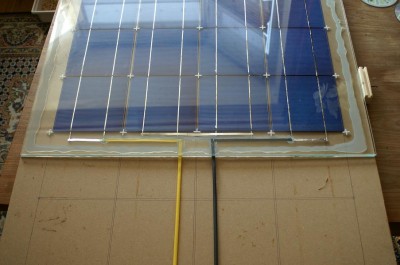
The cells sandwiched between 2 sheets of glass. You can clearly see the cells hooked in series with a (-) at the right (black) and (+) at the left (yellow).
I left it all to dry for a minimum of 24 hours, (the longer the better) due to the sealant vapors.
Then there was still an open space between the 2 glass plates on the outer edge and I filled this with more sealant. Now I had 2 sealant seals, so if one sealant line leaks, there is the 2nd seal as a backup. I left this to dry for another 3 days.
When the sealant dried fully, I took some aluminum framing (aluminum angle bar) to make a frame to protect the glass and to make the panel stronger.
At the back of the panel I made a junction box with a terminal block. At one site of the block the (+) and (–) from the panel is going to the In and at the Out side will go the wire to the inverter.
In the junction box is also a diode in between the (+) from the panel to the (+) going to the inverter. This will prevent electric current from flowing to the panel when the panel is not producing any electricity (like at night).
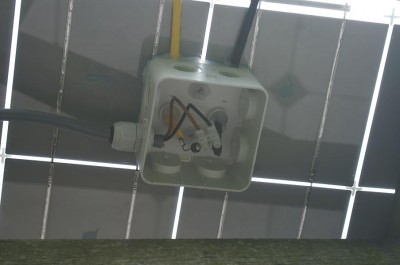
The junction box at the back of the panel with the blocking diode.
The Inverter
I contacted the local solar panel shop for a suitable inverter as this one needs to be small (remember that I am only making a small amount of electricity with this panel). In the shop was a small inverter laying around which could not be sold, which I could have for free. The inverter is an OK-4 one, starting at 24V to 50V and a max of 100W. So this taught me that just one panel would not be enough and would give me only 14V. I needed a 2nd one and also hooked up in series so I would get 28V, which is enough to get the inverter going. The 14V appeared to be enough, but I could see that this was not a strong current, so guess what? I made a 3rd panel and now the production is nice and steady.
I know that this inverter can go to a max of 100W and my 3 panels give more (135Wp) but the panels will be restricted by the inverter. Whenever the inverter gets more than it can handle, the surplus is burned off as heat. Yes, I know what you’re thinking; I’m wasting electricity right at the source. That’s true, but only at the middle of the day for a few hours when the sun is at it’s strongest and the optimum angle to the panels. For most of the day ( and on most days) this is not the case. Now I start producing electricity right away when the sun rises until it sets, thanks to the fact that this inverter is able to work at a low voltage.
I gain more by producing in total at the lower range (every day) than a few hours (at some days) at the top range.
Figure Facts
As the OK-4 inverter doesn’t have a built-in display to see how much output it gives, I needed a separate production meter. I was also not prepared to pay the full “solar panel world price” for this, either. I went to a local DIY store and bought an ELRO M12 Power Calculator, which is actually meant for calculating the usage of electrical appliances, but it also works fine to calculate any solar production (this calculator is working both ways: it can give and take electricity from the net). This calculator plugs straight into the main power supply with no difficult wiring, just as I needed.
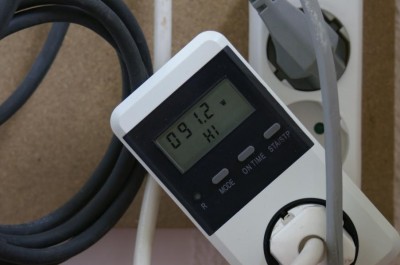
The ELRO M12 production meter with 91W of home build solar power.
Factory figures told me that each cell gives 0.5V x 6A = 3Wp, but only in ideal circumstances. For a whole panel, this would mean 28 cells x 3Wp = 84Wp. From previous experience, I knew that this is always given as an optimistic figure and that approximatley 20% less production will be achieved in reality. In this case, this would mean a true expected production figure of 67Wp.
My panels are certainly not facing in an optimum direction, but this is also not the purpose (as silly as it sounds) for now. The panels are placed at a 10 degree angle (instead 35) and not exactly facing South.
But where they are placed is a temporary installation for the reason that I want to see how they’re behaving in real weather with cold temperatures, lots of rain and a blasting sun. A real setup will come in the near future.
Taking all of this into account, the panels are producing 15V x 3A = 45Wp each. I conclude that the voltage of the cells are used to the maximum. The amperage can go higher, but this can be done by changing the angle of the panels more into the sun. This is currently not possible due to their placement location. If I see that voltage- wise, the maximum output has been reached, I can say that the panels are working fine and do the give (so far) an average of 500Wh per week.
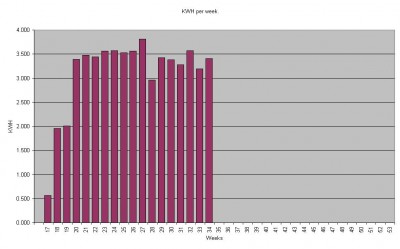
Weekly production record from week 17 till 34.
Now the critics among us will say that this is nothing. Given that the panels have the potential to produce more if I only change their angle, the panels are smaller than standard panels, plus there are only 3 panels, they do quite well. Plus, my aim was to overcome the standby appliances in the house so you could say that I succeeded.
Apart from the durability (this test is currently on going), I can say that a homemade panel is working just as well as a store-bought panel.
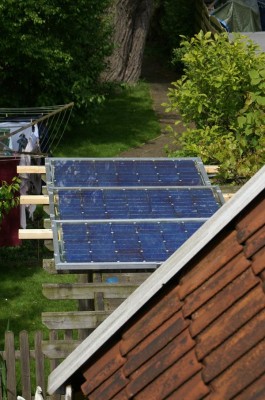
The 3 panels harvesting the sun.
Future Thoughts
My future plan is first testing the panels for their durability as I mainly focused on making them and do I not really know what they will do after being exposed to the weather for a long period of time.
After this, it’s time to make a sun tracker and make more panels but also bigger ones. Then the panels will give more output due to the increased size and will always be facing at the right angle to the sun for maximum output.
And it speaks for itself that all gained knowledge will be published on the site for everyone to access.
And for the Critic, yes you’re right that this is not free electricity as I had to pay for the parts, but when I reach the break-even point, the costs are paid back. Then the system will give me free energy by harvesting the sun.
To share my experiences I’ve made a website where you can see for yourself how I did it, my production records to show how the system is behaving, and how you can do this yourself by means of text, photos and films. Why wait till tomorrow if you can start saving money today?
Hans Maas, weblog: Home Build Solar System
Home Build Solar System is the website where you can get the information you need to build your own solar system.
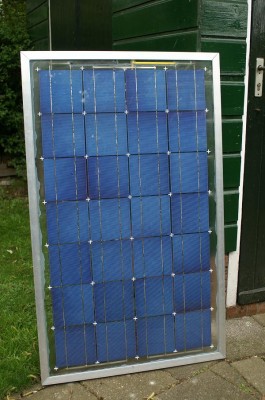





7 replies on “Home Build Solar System”
The silicon industry is or has been slow to increase overall manufacturing capabilities because of the large growth during the early 1990s that eventually when stale. The extreme growth expectations were hyped and many industry experts expected much expansion in the early 1990s. This just did not happen 18 years ago. Fortunately, we are now experience much more accepting market, social expectations of our movement to renewable technologies, and governmental support to make the switch to home solar power.
There are now Solar cells from people like Nanosolar,http://
http://www.nanosolar.com/technology#white Firstsolar
http://www.firstsolar.com/residential_roof_power_plants.php
and Chinease QS Solar
http://solarplaza.com/trade/?utm_source=Solarplaza+SUN&utm_campaign=2d274cce33-SUN&utm_medium=email
who are selling solar cell of the Thinfilm variety which are priced at
about $1/Wp. These cells are easy to assemble to solar Panels and cost
much lesser. First two do not yet sell in small quantity. They are of
lesser efficiency than crystalline solar cells. Hope Space will not be
a problem for Home systems. The out put will increase by almost 25 to
35% if you use trackers and single axis tracker are sufficient for
home systems as the other axis change can be made manually as the time
changes. Good to note the good work started by these people and we
wish them all the best
A presentation made at the Institution of Engineers Sri Lanka for Solar home systems for large domestic consumers with Net metering. Please see the presentation hear http://www.scribd.com/doc/17302887/Buy-Power-During-the-Night-Final-PDF
i am very much disturbed by my electric supply and bill. this is cheaper polution free way getting electricity
needed in pakistan
Its great to know that other Pakistanis are also chasing solar solutions. Man we are devastated due to shortfall of electricity. Pakistan is a hot country (40 to 48 degree celsius in day), and I think we can generate a whole lot of solar electiricity. In Pakistan following company sales solar equipment
http://www.highnooninternational.com/
I would suggest that every one should pursue with one’s govt it should encourage solar energy use by subsidising its procurement and forcing electric utility companies to buy back the surplus energy through grid tied solar system so that investment on solar system is fully utilised. Let us get together on some forum to pursue the case with govt.